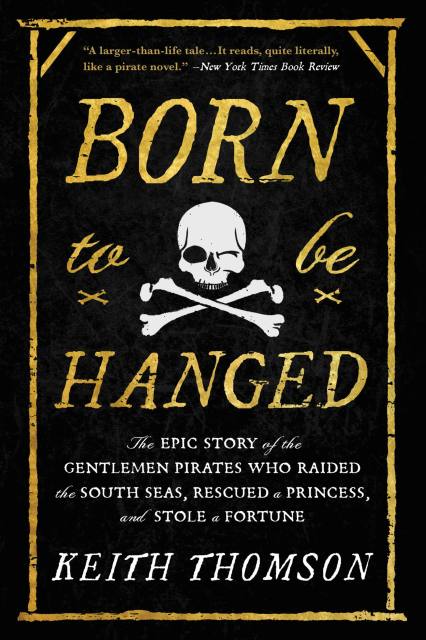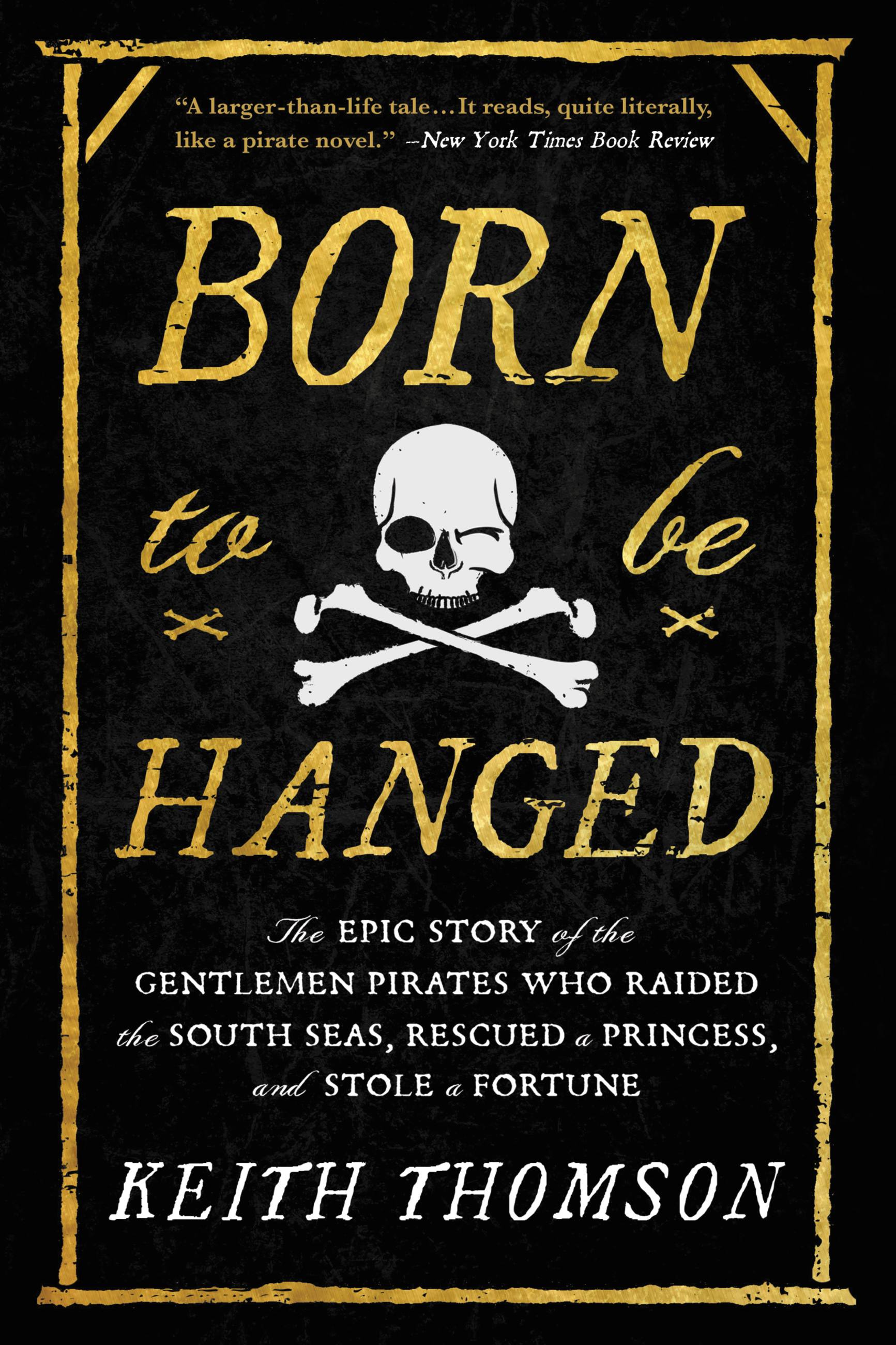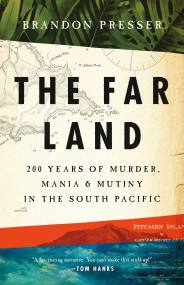Promotion
Shop now and save 20% on your back-to-school purchases & get free shipping on orders $45+ Use code: SCHOOL24
Born to Be Hanged
The Epic Story of the Gentlemen Pirates Who Raided the South Seas, Rescued a Princess, and Stole a Fortune
Contributors
Formats and Prices
Price
$21.99Price
$28.99 CADFormat
Format:
- Trade Paperback $21.99 $28.99 CAD
- ebook $12.99 $16.99 CAD
- Hardcover $40.00 $50.00 CAD
- Audiobook Download (Unabridged) $27.99
This item is a preorder. Your payment method will be charged immediately, and the product is expected to ship on or around May 16, 2023. This date is subject to change due to shipping delays beyond our control.
Also available from:
Discover the “fascinating and outrageously readable” account of the roguish acts of the first pirates to raid the Pacific in a crusade that ended in a sensational trial back in England—perfect for readers of Nathaniel Philbrick and David McCullough (Douglas Preston, #1 New York Times bestselling author of The Lost City of the Monkey God)
The year is 1680, in the heart of the Golden Age of Piracy, and more than three hundred daring, hardened pirates—a potent mix of low-life scallywags and a rare breed of gentlemen buccaneers—gather on a remote Caribbean island. The plan: to wreak havoc on the Pacific coastline, raiding cities, mines, and merchant ships. The booty: the bright gleam of Spanish gold and the chance to become legends. So begins one of the greatest piratical adventures of the era—a story not given its full due until now.Inspired by the intrepid forays of pirate turned Jamaican governor Captain Henry Morgan—yes, that Captain Morgan—the company crosses Panama on foot, slashing its way through the Darien Isthmus, one of the thickest jungles on the planet, and liberating a native princess along the way. After reaching the South Sea, the buccaneers, primarily Englishmen, plunder the Spanish Main in a series of historic assaults, often prevailing against staggering odds and superior firepower. A collective shudder racks the western coastline of South America as the English pirates, waging a kind of proxy war against the Spaniards, gleefully undertake a brief reign over Pacific waters, marauding up and down the continent.
With novelistic prose and a rip-roaring sense of adventure, Keith Thomson guides us through the pirates’ legendary two-year odyssey. We witness the buccaneers evading Indigenous tribes, Spanish conquistadors, and sometimes even their own English countrymen, all with the ever-present threat of the gallows for anyone captured. By fusing contemporaneous accounts with intensive research and previously unknown primary sources, Born to Be Hanged offers a rollicking account of one of the most astonishing pirate expeditions of all time.
-
“Thomson does a fine job mining the historical record for all this swash and buckle… it reads, quite literally, like a pirate novel.”Tina Jordan, New York Times Book Review
-
“Unleashes an epic history of a band of ‘gentlemen pirates.’”Ron Charles, Washington Post
-
“It’s hard to believe that serious maritime history could be quite so fascinating and outrageously readable. Born to Be Hanged is one of those books you simply can’t put down, a true history of a band of buccaneers who embark on a two-year rampage along the Pacific coasts of Central and South America, undertaking a series of daring, insane, and bloody raids that are at times so improbable as to defy belief. This is a truly marvelous read and I highly recommend it.”Douglas Preston, #1 New York Times bestselling author of The Lost City of the Monkey God
-
“This swashbuckling history recounts a two-yearlong pirate raid in the 17th century along the Pacific coastline, with over 300 dastardly buccaneers in search of Spanish gold.”Barbara VanDenburgh, USA Today
-
“Thomson is an engaging and enthusiastic writer.”The Economist
-
“A rollicking historical account… Every action-packed page is certain to thrill connoisseurs of piracy and seafaring history… Thomson fleshes out each audacious attack and narrow escape with wit and insight… By focusing on the individuals who kept accounts of the adventure, Thomson humanizes the ‘Brethren of the Coast,’ shedding light on their motivations, histories, and relationships.”Sara Shreve, Library Journal (starred review)
-
“A brisk and entertaining adventure story… Thomson unravels the complex relationship between piracy and colonial governments in the Americas, where England and Spain struggled for primacy, and describes local tribes and flora and fauna in meticulous detail.”Publishers Weekly
-
“Thomson eloquently proves Mark Twain’s oft-cited adage, ‘Truth is stranger than fiction.’ Thanks to lively writing and thorough research, Thomson’s pirates burst from the pages as vividly and compellingly as those in the Pirates of the Caribbean film series... The entertaining suspense and high energy continue to the very end.”John Rowen, Booklist
-
“What a rollicking ride! Born to Be Hanged is serious narrative history delivered as gripping entertainment, with all the panache of an adventure novel. Keith Thomson unspools the excesses and escapades of the high seas in what we come to see is truly the Golden Age of Piracy. From the signing of the buccaneers’ initial charter to their life-or-death trial back in England two years later, I followed every battle, chase, and standoff with rapt attention. Thomson not only brings the seventeenth century to life in vivid detail; he weaves his humor and keen observations into the character studies of the pirates themselves. This book is a riveting historical delight not to be missed.”Keith O’Brien, author of the New York Times bestseller Fly Girls: How Five Daring Women Defied All Odds and Made Aviation History
-
“Born to Be Hanged is swashbuckling narrative nonfiction at its best. Thomson skillfully weaves in the history and geopolitics of the period even as he puts the reader in the middle of an action-packed thriller that does not let up. By the end of this myth-busting, stranger-than-fiction tale, I wanted to raise a tankard of rum and toast the death-defying adventures of the greatest buccaneers of the seventeenth-century.”James L. Swanson, author of the New York Times bestseller Manhunt: The Twelve-Day Chase for Lincoln’s Killer
-
“Born to Be Hanged is a thrilling tale of piracy in the South Seas, replete with pitched and bloody battles, treasure hoards, a daring rescue, violent storms, shifting allegiances, mutiny, and a dubious trial. It is full of so many fascinating details and surprising twists and turns that you will not want to put it down until the very end. A wonderful contribution to the history of piracy, and a welcome addition to every pirate lover's library.”Eric Jay Dolin, bestselling author of Black Flags, Blue Waters: The Epic History of America’s Most Notorious Pirates
-
“Born to Be Hanged tells the dazzling true story of one of the brashest, riskiest, and all-out swashbucklingest pirating adventures ever attempted—a mission that takes an outmanned band of English buccaneers across one deadly jungle, over two oceans, through the heart of the Spanish Main, and into endless trouble. Along the way, they come upon plenty of treasure—and readers will, too.”Miles Harvey, author of The King of Confidence
- On Sale
- May 16, 2023
- Page Count
- 384 pages
- Publisher
- Back Bay Books
- ISBN-13
- 9780316703635
Newsletter Signup
By clicking ‘Sign Up,’ I acknowledge that I have read and agree to Hachette Book Group’s Privacy Policy and Terms of Use







